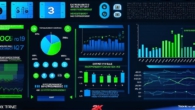
How do you make an NFT
Non-Fungible Tokens (NFTs) have been making waves in the art and collectibles industry since their inception. These unique digital assets represent ownership of a piece of artwork or content, allowing creators to monetize it while also providing value to collectors.
Selecting the Right Platform
The first step in creating an NFT is selecting the right platform for your project. There are several options available, each with its own pros and cons. The most popular platforms include OpenSea, Rarible, and SuperRare. These platforms allow you to create and sell your NFTs, as well as connect with potential buyers.
When choosing a platform, consider the following factors:
- Fees: Different platforms charge different fees for minting and selling NFTs. Some charge a flat fee, while others take a percentage of each sale. Be sure to research the fees associated with your chosen platform.
- Audience: Each platform has its own audience, which may or may not be interested in your type of content. Research the demographics of the platform and determine if it aligns with your target market.
- Ease of use: Some platforms are more user-friendly than others. Consider how much technical expertise you have and choose a platform that is easy to navigate.
Minting Your NFT
Once you’ve selected a platform, the next step is to mint your NFT. This process involves creating a digital asset and associating it with an NFT token on the blockchain. The process can vary depending on the platform you choose, but generally involves the following steps:
- Create your digital asset: This could be a piece of artwork, a collectible item, or any other type of content that you want to monetize as an NFT. Save your file in a format that is compatible with your chosen platform.
- Upload your digital asset: Log in to your platform account and navigate to the “Mint” or “Create” section. Upload your digital asset and provide any necessary details about your project, such as the title, description, and price.
- Set your token standards: You will need to select a token standard for your NFT. The most popular standards include ERC-721 and ERC-1155. These standards define how your NFT will be stored on the blockchain and how it can be traded.
- Approve the contract: Once you’ve set your token standards, you will need to approve the contract associated with your chosen platform. This is a simple process that typically involves clicking a button.
- Mint your NFT: Finally, click the “Mint” button and wait for your NFT to be created on the blockchain. Once it’s ready, you can view it in your account dashboard.
Marketing Your NFT
Now that you’ve minted your NFT, it’s time to start promoting it. There are several ways to market your NFT and attract potential buyers:
- Social media: Use social media platforms such as Twitter, Instagram, and Facebook to showcase your NFT and engage with potential buyers. Share behind-the-scenes content, teasers, and other updates to keep your audience interested.
- Online marketplaces: In addition to your chosen platform, consider listing your NFT on other online marketplaces such as OpenSea or Rarible. This will increase visibility and attract potential buyers who may not be familiar with your chosen platform.
- Collaborations: Partnering with other creators or influencers can help promote your NFT to a wider audience. Consider collaborating on a project or cross-promoting each other’s work.
- Auctions: Hosting an auction for your NFT can be a great way to generate excitement and attract potential buyers. Set a starting price and allow bids to increase, creating a sense of urgency and driving up the value of your NFT.
Real-Life Examples
Now that you have a better understanding of the process, let’s look at some real-life examples of successful NFT projects:
1. Beeple’s Everydays
In 2021, artist Mike Winkelmann (better known as Beeple) created a unique piece of artwork every day for over two years. Each piece was turned into an NFT and sold on the open market, generating millions of dollars in revenue. This project showcases the potential for NFTs to be used as a new form of currency and store of value.
2. CryptoKitties
CryptoKitties is a blockchain-based game that allows players to breed and sell digital cats as NFTs. The game was launched in 2017 and quickly became one of the most popular decentralized applications on Ethereum, with millions of users and billions of dollars worth of transactions. CryptoKitties showcases the potential for NFTs to be used as a form of entertainment and collectibles.
FAQs
1. What are the requirements for creating an NFT?
To create an NFT, you will need to select a platform, mint your digital asset, set your token standards, approve the contract, and market your NFT to potential buyers.
2. How do I price my NFT?
The price of your NFT will depend on various factors such as rarity, demand, and the value of the underlying asset. Research similar NFTs in your chosen category and use that information to determine a fair market price for your project.

3. Can I sell my NFT offline?
While most NFT sales occur online through cryptocurrency exchanges and marketplaces, it is possible to sell NFTs offline through private transactions or auctions. However, this may require additional setup and marketing efforts.
Conclusion
Creating an NFT can be a rewarding and profitable venture for artists, collectors, and entrepreneurs alike. By selecting the right platform, minting your digital asset, marketing your NFT effectively, and learning from successful projects like Beeple’s Everydays and CryptoKitties, you can create a unique and valuable piece of digital art that will appeal to your target audience.







